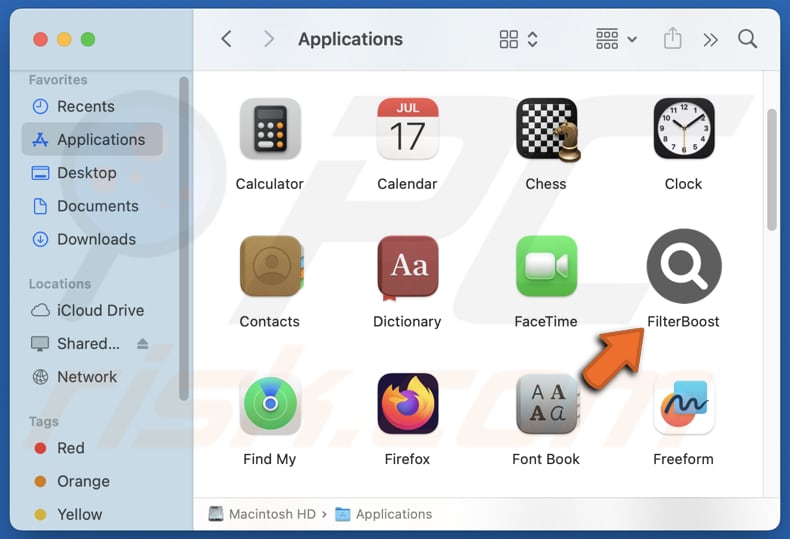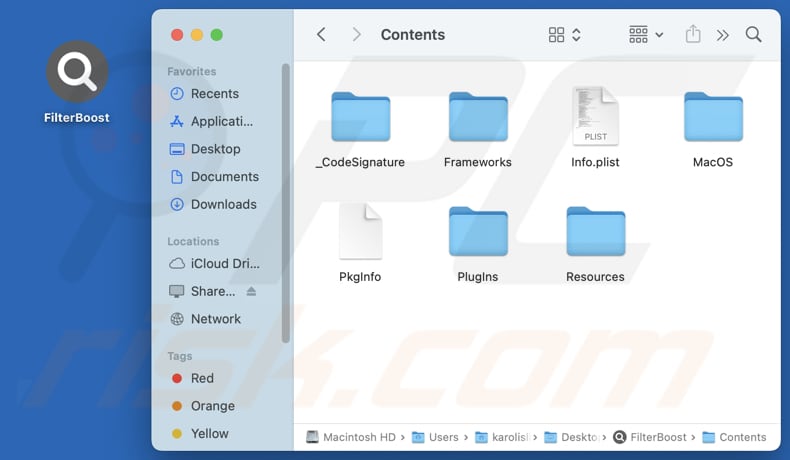Get free scan and check if your device is infected.
Remove it nowTo use full-featured product, you have to purchase a license for Combo Cleaner. Seven days free trial available. Combo Cleaner is owned and operated by RCS LT, the parent company of PCRisk.com.
What is FilterBoost?
FilterBoost is a dubious application that our team has discovered while examining questionable pages. We have inspected FilterBoost and found that it delivers unwanted advertisements. For this reason, we have classified FilterBoost as adware. Users are advised against installing applications of this type.

FilterBoost adware in detail
The types of ads that FilterBoost may show include intrusive pop-up ads. banners, coupons, video ads, and similar. Since FilterBoost is not a reliable application, its ads may take users to potentially malicious websites, like phishing sites designed to steal sensitive information (e.g., credit card details or passwords).
Also, ads from FilterBoost may take users to technical support scams designed to trick users into paying for fake (or unnecessary) services or products, revealing personal information, providing scammers remote access to their computers, or downloading malware. Also, ads generated by FilterBoost may direct users to fake lotteries, giveaways, and similar schemes.
Furthermore, interacting with ads shown by FilterBoost might trigger unwanted downloads and installations. FilterBoost may also be designed to collect data, including browsing history, search queries, visited websites, IP addresses, location data, and more.
Moreover, FilterBoost may consume system resources and be difficult to remove without specialized tools. Overall, users should avoid installing FilterBoost and remove it from affected computers as soon as possible.
| Name | Ads by FilterBoost |
| Threat Type | Adware, Mac malware, Mac virus |
| Detection Names | Avast (MacOS:Adload-AG [Adw]), Combo Cleaner (Gen:Variant.Adware.MAC.AdLoad.13), ESET-NOD32 (A Variant Of OSX/Adware.Synataeb.H), Kaspersky (Not-a-virus:HEUR:AdWare.OSX.Adload.j), Full List (VirusTotal) |
| Additional Information | This application belongs to Adload malware family. |
| Symptoms | Your Mac becomes slower than normal, you see unwanted pop-up ads, you are redirected to dubious websites. |
| Distribution methods | Deceptive pop-up ads, free software installers (bundling), torrent file downloads. |
| Damage | Internet browser tracking (potential privacy issues), display of unwanted ads, redirects to dubious websites, loss of private information. |
| Malware Removal (Windows) |
To eliminate possible malware infections, scan your computer with legitimate antivirus software. Our security researchers recommend using Combo Cleaner. Download Combo CleanerTo use full-featured product, you have to purchase a license for Combo Cleaner. 7 days free trial available. Combo Cleaner is owned and operated by RCS LT, the parent company of PCRisk.com. |
Conclusion
In conclusion, adware is software that can diminish computing experience by presenting intrusive and potentially misleading advertisements, and it can also impact computer performance. Also, adware can cause privacy risks by collecting various types of data. Additional examples of apps that function as adware are AppRecognition, SectionDesign, and AppSection.
How did FilterBoost install on my computer?
Usually, users install adware unintentionally. Pretty often, adware is distributed together with free programs. In such cases, adware is mentioned in "Advanced", "Custom", or similar settings, or near ticked checkboxes. Users install adware alongside other software when they leave those settings unchanged, or checkboxes ticked.
Users can also install adware through deceptive ads and pop-ups, fake software updates, downloads from P2P networks, unofficial websites, third-party app stores, and similar channels.
How to avoid installation of unwanted applications?
Always download programs and files from official websites and app stores. Avoid executing downloads from unreliable sources (examples are mentioned in the previous paragraph). When installing software, look for additional apps and deselect them if you do not wish to install them.
Do not allow questionable sites to send you notifications or click ads, pop-ups, buttons, etc., appearing suspicious web pages. Additionally, keep the operating system and installed software up to date, and use reputable security software for protection. If your computer is already infected with FilterBoost, we recommend running a scan with Combo Cleaner Antivirus for Windows to automatically eliminate this adware.
A pop-up that appears after the installation of FilterBoost adware:

FilterBoost's installation folder:

Instant automatic malware removal:
Manual threat removal might be a lengthy and complicated process that requires advanced IT skills. Combo Cleaner is a professional automatic malware removal tool that is recommended to get rid of malware. Download it by clicking the button below:
DOWNLOAD Combo CleanerBy downloading any software listed on this website you agree to our Privacy Policy and Terms of Use. To use full-featured product, you have to purchase a license for Combo Cleaner. 7 days free trial available. Combo Cleaner is owned and operated by RCS LT, the parent company of PCRisk.com.
Quick menu:
- What is FilterBoost?
- STEP 1. Remove FilterBoost related files and folders from OSX.
- STEP 2. Remove FilterBoost ads from Safari.
- STEP 3. Remove FilterBoost adware from Google Chrome.
- STEP 4. Remove FilterBoost ads from Mozilla Firefox.
Video showing how to remove FilterBoost adware using Combo Cleaner:
FilterBoost adware removal:
Remove FilterBoost-related potentially unwanted applications from your "Applications" folder:

Click the Finder icon. In the Finder window, select "Applications". In the applications folder, look for "MPlayerX", "NicePlayer", or other suspicious applications and drag them to the Trash. After removing the potentially unwanted application(s) that cause online ads, scan your Mac for any remaining unwanted components.
DOWNLOAD remover for malware infections
Combo Cleaner checks if your computer is infected with malware. To use full-featured product, you have to purchase a license for Combo Cleaner. 7 days free trial available. Combo Cleaner is owned and operated by RCS LT, the parent company of PCRisk.com.
Remove adware-related files and folders

Click the Finder icon, from the menu bar. Choose Go, and click Go to Folder...
 Check for adware generated files in the /Library/LaunchAgents/ folder:
Check for adware generated files in the /Library/LaunchAgents/ folder:

In the Go to Folder... bar, type: /Library/LaunchAgents/

In the "LaunchAgents" folder, look for any recently-added suspicious files and move them to the Trash. Examples of files generated by adware - "installmac.AppRemoval.plist", "myppes.download.plist", "mykotlerino.ltvbit.plist", "kuklorest.update.plist", etc. Adware commonly installs several files with the exact same string.
 Check for adware generated files in the ~/Library/Application Support/ folder:
Check for adware generated files in the ~/Library/Application Support/ folder:

In the Go to Folder... bar, type: ~/Library/Application Support/

In the "Application Support" folder, look for any recently-added suspicious folders. For example, "MplayerX" or "NicePlayer", and move these folders to the Trash.
 Check for adware generated files in the ~/Library/LaunchAgents/ folder:
Check for adware generated files in the ~/Library/LaunchAgents/ folder:

In the Go to Folder... bar, type: ~/Library/LaunchAgents/

In the "LaunchAgents" folder, look for any recently-added suspicious files and move them to the Trash. Examples of files generated by adware - "installmac.AppRemoval.plist", "myppes.download.plist", "mykotlerino.ltvbit.plist", "kuklorest.update.plist", etc. Adware commonly installs several files with the exact same string.
 Check for adware generated files in the /Library/LaunchDaemons/ folder:
Check for adware generated files in the /Library/LaunchDaemons/ folder:

In the "Go to Folder..." bar, type: /Library/LaunchDaemons/

In the "LaunchDaemons" folder, look for recently-added suspicious files. For example "com.aoudad.net-preferences.plist", "com.myppes.net-preferences.plist", "com.kuklorest.net-preferences.plist", "com.avickUpd.plist", etc., and move them to the Trash.
 Scan your Mac with Combo Cleaner:
Scan your Mac with Combo Cleaner:
If you have followed all the steps correctly, your Mac should be clean of infections. To ensure your system is not infected, run a scan with Combo Cleaner Antivirus. Download it HERE. After downloading the file, double click combocleaner.dmg installer. In the opened window, drag and drop the Combo Cleaner icon on top of the Applications icon. Now open your launchpad and click on the Combo Cleaner icon. Wait until Combo Cleaner updates its virus definition database and click the "Start Combo Scan" button.

Combo Cleaner will scan your Mac for malware infections. If the antivirus scan displays "no threats found" - this means that you can continue with the removal guide; otherwise, it's recommended to remove any found infections before continuing.

After removing files and folders generated by the adware, continue to remove rogue extensions from your Internet browsers.
Remove malicious extensions from Internet browsers
 Remove malicious Safari extensions:
Remove malicious Safari extensions:

Open the Safari browser, from the menu bar, select "Safari" and click "Preferences...".

In the preferences window, select "Extensions" and look for any recently-installed suspicious extensions. When located, click the "Uninstall" button next to it/them. Note that you can safely uninstall all extensions from your Safari browser - none are crucial for regular browser operation.
- If you continue to have problems with browser redirects and unwanted advertisements - Reset Safari.
 Remove malicious extensions from Google Chrome:
Remove malicious extensions from Google Chrome:

Click the Chrome menu icon ![]() (at the top right corner of Google Chrome), select "More Tools" and click "Extensions". Locate all recently-installed suspicious extensions, select these entries and click "Remove".
(at the top right corner of Google Chrome), select "More Tools" and click "Extensions". Locate all recently-installed suspicious extensions, select these entries and click "Remove".

- If you continue to have problems with browser redirects and unwanted advertisements - Reset Google Chrome.
 Remove malicious extensions from Mozilla Firefox:
Remove malicious extensions from Mozilla Firefox:

Click the Firefox menu ![]() (at the top right corner of the main window) and select "Add-ons and themes". Click "Extensions", in the opened window locate all recently-installed suspicious extensions, click on the three dots and then click "Remove".
(at the top right corner of the main window) and select "Add-ons and themes". Click "Extensions", in the opened window locate all recently-installed suspicious extensions, click on the three dots and then click "Remove".

- If you continue to have problems with browser redirects and unwanted advertisements - Reset Mozilla Firefox.
Frequently Asked Questions (FAQ)
What harm can adware cause?
Installing adware on your computer can interfere with your web browsing and other activities. Additionally, adware can slow down your system's performance by consuming resources. Moreover, software can pose privacy and security risks.
What does adware do?
Adware generates various advertisements, including pop-ups, banners, and video ads. In addition to displaying ads, adware can collect data such as browsing history and personal information and may hijack browsers by changing settings like the default search engine or homepage.
How do adware developers generate revenue?
Adware developers generally make money by advertising different products, websites, or services. They primarily earn through affiliate programs, receiving commissions for directing traffic or boosting sales via the ads they show.
Will Combo Cleaner remove FilterBoost adware?
Yes, Combo Cleaner will scan your computer and remove all installed adware-type applications. However, manual removal might not be completely effective, as some files or other components could remain hidden. Therefore, using tools like Combo Cleaner is recommended for thorough adware removal.
Share:

Tomas Meskauskas
Expert security researcher, professional malware analyst
I am passionate about computer security and technology. I have an experience of over 10 years working in various companies related to computer technical issue solving and Internet security. I have been working as an author and editor for pcrisk.com since 2010. Follow me on Twitter and LinkedIn to stay informed about the latest online security threats.
PCrisk security portal is brought by a company RCS LT.
Joined forces of security researchers help educate computer users about the latest online security threats. More information about the company RCS LT.
Our malware removal guides are free. However, if you want to support us you can send us a donation.
DonatePCrisk security portal is brought by a company RCS LT.
Joined forces of security researchers help educate computer users about the latest online security threats. More information about the company RCS LT.
Our malware removal guides are free. However, if you want to support us you can send us a donation.
Donate
▼ Show Discussion